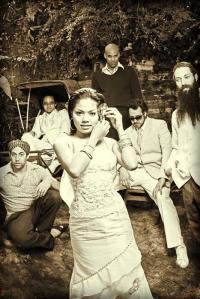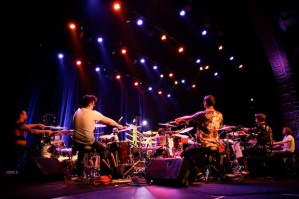Where did the interest in Cambodian music come from?
I travelled to Cambodia in 1995 and i was in a taxi cab and the driver was playing this really weird 80’s music and it was all crazy medleys of Madonna mixed with the stones and then the clash would come in but it was all in Cambodian. I thought this is really weird, I thought I gotta find some of this music for myself you know. So I went to a market and I found this cassette booth and this guy had one mother-ship cassette machine with all these crazy wires sticking out of it plugged into all these baby machines around it. So when you picked something he would copy it right on the spot and give you some random cover so you never knew what you were getting. When I was there I noticed all these 60’s looking drawings and paintings and I thought wow, what is this old stuff? So I picked some of those and it was all these crazy psychedelic music. So that’s when I first got turned on to it and then my other band-mates got turned onto it in different ways. So we all had this interest in this music, we’re not purists or crazy Cambodian freaks, it was just something that we were interested in and it was an idea that was sparked and we just managed to see it through you know.
How did you find each other?
Me and Zack, the guy with the long beard, have been friends since we were teenagers. We talked about checking out this psychedelic Cambodian rock and at the same time tropicalia was happening so we were checking out the old Brazilian music and there was this old Turkish music, so we were all into this old stuff. Zack and Ethan were playing pool in a local pool hall and they befriended this Cambodian dude, and he said hey man you should go to Long Beach, that’s where all the Cambodians are. That’s where all the crazy clubs are. So they went down there and found that it was Chinese style synthy pop real cheesy, but they heard the singing it was the exact same voices and same melodies as the old stuff we like. It was like a light went off. What if we supply the band and we find one of these ladies to do the singing. So it was the two of them who went searching for the singers but it was all of us who rented a rehearsal space and tried out all the singers.
It seems like a far fetched idea, even now after having seen you play a couple of times and having heard your albums.
It was totally bizarre that was the appeal. We didn’t just want to be another indie rock band from Los Angeles. We wanted to something that was taking ourselves out of the element. We wanted to do something strange but something strong or proud because a lot of the music was apathetic, like we’re in a rock band but we’re not that good. That was the attitude of some of the bands. And when you see Nimol sing she’s like here I am this is what I am. I’m a singer and I’m out here doing my thing. We noticed right away that Nimol just had it. On our first show we were at a local club, people were dancing like crazy, jumping up on stage, which is rare in LA. It really jazzed us. We thought we could do this a few more times. It was never meant to be a project this long, we had a couple of concerts in mind and we just wanted to do it for fun and it’s flowered in such a way that it’s just become hard to stop.
I found your film Sleepwalking thru the Mekong really amazing. Were you worried about how you’d be received in Cambodia?
Definitely worried because we wanted to go to Cambodia but we didn’t know how we could pay or afford to go to Cambodia as a band. So we came up with this idea that maybe we could raise the money to go there and play and we could make a film. So we came up with the idea and had to completely lie about all these wonderful things we were doing in Cambodia in order to get the investments to give us money, and none of that stuff happened, but all this other great stuff happened. It was very scary we had no idea what t expect and Nimol was frightened too, she didn’t help us feel any better, she was like I don’t know what’s going to happen. So when we got over there and played this music it endeared us to the people. The second day we got to Phnom Penh, we played on national tv and they loved the show so much that the tv station aired it 3 times a day for the entire month that we were there, so we couldn’t go anywhere. I mean I saw Zack walking down the street with a Cambodian scarf wrapped completely around his head, his beard tucked inside his shirt and he had a pair of glasses on. He was like I have to stop and sing to everybody. Every two feet I have to stop and sing to another Cambodian. Me being a 6 foot 6 black dude and him with the big beard the two of us stick out. The thing is you go to these little tiny villages in Cambodia that have no electricity. Every few shacks have a fluorescent light that runs off a car battery and a tv that runs off a car battery, so everybody across the entire country got this show. So even when we travelled across the countryside and would stop in a one cow little village people new us.
Now you know how Lady Gaga feels.
You know what’s funny about Lady Gaga. I really can’t tell her from other people. Maybe that’s why she’s so popular, I can’t tell her from another woman. They say androgynous about sex but she’s like without a look, she’s like invisible looking or something.
You guys look very interesting on stage, you’re individual characters. When I first saw you I thought you were a team of super heroes.
I think we should make action figures. In heart we’re all the same, but we definitely are completely different. There’s nothing calculated. When we walk down the street we all look like we’re from different bands.
You don’t look like the Ramones, put it that way.
Laughs.
You’re the giant, the guitarist is the dude from zz top, you’ve got a pawn shop dealer on the keyboards…I could go on…
I’ll make sure I let him I know that one.
I’ll make make sure never to introduce myself to him.
If you meet him be prepared to duck
The other thing that struck me about Sleepwalking Through the Mekong was how the music is so tied up with the genocide there. Were you aware of this when you began?
When we started the band we really didn’t know much about Cambodian history. I travelled to Cambodia and I knew about the khmer rouge and I knew about the time period that it happened, but getting to know Nimol and this band has made me get to know more about the people of Cambodia and how they’re coping with this travesty, that still affects the culture now. Because basically all their educators, their architects, musicians, anyone with an education either left or was murdered. Cambodia really was stripped of its culture. It wasn’t a genocide across all classes, all classes of people died, but the first to die were all the educators, the thinkers and artists. It really today is seriously affecting Cambodia and its culture. I didn’t have a real grip on that when I started the band. As we progressed, making that film and we’ve worked with a few aid organizations, and things are presenting themselves, so it’s something that we do.
I hear you’re working on a new album.
I’m sitting outside the studio and the other guys are working on some keyboards right now, we’ve been heavily into recording the past few months. So when we come to Australia we’ll definitely be playing a few of the new ones.
How’s it going, do you feel like there’s much progression?
As we put out more and more records we keep on trying to push ourselves to something new. Nimol started to sing in harmonies, it’s very new for her because Cambodian music is one singer or many singers singing in the same register or key. So now we’re starting to experiment. we’re bringing friends and getting little more orchestrated, we’re going for a little more of a larger sound on some of the recordings.
I was a big fan of your Mulatu Astatke track.
I’ve never seen him play, our keyboard player saw him in LA and said it was amazing. All those ethiopique albums are so perfect, that music just reminds me of a flock of birds taking off, it’s just beautiful





